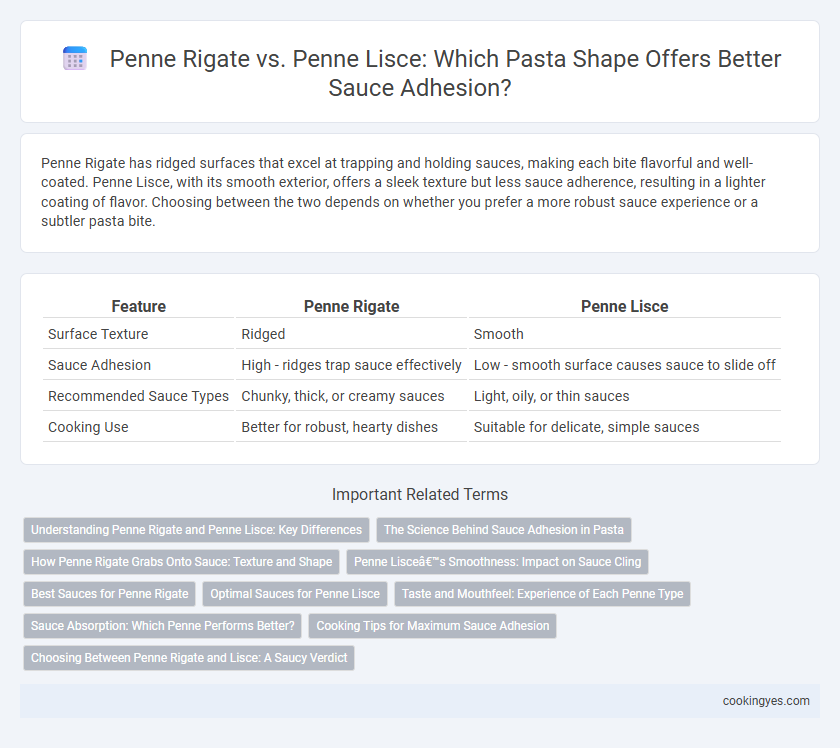Penne Rigate has ridged surfaces that excel at trapping and holding sauces, making each bite flavorful and well-coated. Penne Lisce, with its smooth exterior, offers a sleek texture but less sauce adherence, resulting in a lighter coating of flavor. Choosing between the two depends on whether you prefer a more robust sauce experience or a subtler pasta bite.
Table of Comparison
| Feature | Penne Rigate | Penne Lisce |
|---|---|---|
| Surface Texture | Ridged | Smooth |
| Sauce Adhesion | High - ridges trap sauce effectively | Low - smooth surface causes sauce to slide off |
| Recommended Sauce Types | Chunky, thick, or creamy sauces | Light, oily, or thin sauces |
| Cooking Use | Better for robust, hearty dishes | Suitable for delicate, simple sauces |
Understanding Penne Rigate and Penne Lisce: Key Differences
Penne Rigate features ridges along its surface that enhance sauce adhesion by trapping thicker and chunkier sauces, making each bite flavorful. Penne Lisce has a smooth surface, ideal for lighter, cream-based sauces that cling without excess texture. Understanding these structural differences helps choose the perfect penne type to maximize sauce retention and flavor intensity in various pasta dishes.
The Science Behind Sauce Adhesion in Pasta
Penne Rigate, characterized by its ridged surface, enhances sauce adhesion by increasing the pasta's surface area and creating microtextures that trap sauce particles more effectively than the smooth Penne Lisce. The ridges promote better retention of both chunky and creamy sauces due to capillary action and increased friction between the pasta and sauce molecules. This surface morphology directly influences flavor delivery, making Penne Rigate a preferred choice for robust, thick sauces.
How Penne Rigate Grabs Onto Sauce: Texture and Shape
Penne Rigate features ridged surfaces and slightly curved tubes that increase texture, creating more surface area for sauces to cling to. The ridges help trap thicker sauces like marinara or pesto, enhancing flavor absorption and preventing sauce from slipping off. In contrast, Penne Lisce's smooth exterior offers less grip, making it better suited for lighter, oil-based sauces.
Penne Lisce’s Smoothness: Impact on Sauce Cling
Penne Lisce's smooth surface results in less sauce adhesion compared to Penne Rigate, which features ridged grooves designed to trap sauces effectively. This smoothness causes sauces to glide off rather than cling, making Penne Lisce ideal for lighter, creamier sauces that require less absorption. Understanding these textural differences helps in selecting the right pasta shape for optimal flavor and sauce distribution in dishes.
Best Sauces for Penne Rigate
Penne rigate, characterized by its ridged surface, excels at holding thicker and chunkier sauces such as Bolognese, arrabbiata, and creamy pesto due to its grooves that trap sauce effectively. These ridges increase sauce adhesion compared to penne lisce, which has a smooth surface better suited for lighter, oil-based sauces. For optimal flavor in dishes like penne alla vodka or spicy sausage ragu, penne rigate offers superior sauce retention and texture.
Optimal Sauces for Penne Lisce
Penne Lisce, characterized by its smooth surface, pairs best with lighter, oil-based sauces such as pesto, aglio e olio, or delicate tomato sauces that cling without overwhelming the pasta. The lack of ridges means thicker cream or chunky vegetable sauces may slip off, making Penne Lisce ideal for simple, subtle flavors that complement its texture. For optimal sauce adhesion, choosing thin, well-emulsified sauces enhances the mouthfeel and overall taste experience of Penne Lisce.
Taste and Mouthfeel: Experience of Each Penne Type
Penne Rigate features ridges that trap sauce, enhancing flavor intensity and providing a textured bite that complements thicker, chunkier sauces. Penne Lisce, with its smooth surface, offers a lighter mouthfeel and allows the sauce to coat the pasta more evenly, ideal for lighter, cream-based or oil-based sauces. Taste perception varies as Rigate's ridges create bursts of sauce with each chew, while Lisce delivers a more subtle and consistent flavor profile.
Sauce Absorption: Which Penne Performs Better?
Penne Rigate, with its ridged surface, outperforms Penne Lisce in sauce absorption by providing greater texture that traps and holds sauces more effectively. The grooves in Penne Rigate increase surface area and create pockets that enhance sauce adherence, making it ideal for thicker and chunkier sauces. Penne Lisce's smooth exterior causes sauces to slide off more easily, resulting in a less flavorful bite.
Cooking Tips for Maximum Sauce Adhesion
Penne Rigate's ridged surface enhances sauce adherence by creating additional texture that traps thicker sauces like marinara or pesto, making each bite more flavorful. In contrast, Penne Lisce's smooth exterior offers less grip, ideal for lighter, oil-based sauces that coat evenly without clinging excessively. For optimal sauce adhesion, cook Penne Rigate to al dente and toss immediately with the sauce to maximize absorption and flavor integration.
Choosing Between Penne Rigate and Lisce: A Saucy Verdict
Penne Rigate features ridges that enhance sauce adhesion, making it ideal for thick, chunky sauces like marinara and Bolognese, while Penne Lisce's smooth surface suits lighter, cream-based sauces that glide effortlessly. The textured grooves of Penne Rigate trap herbs and bits of meat, intensifying flavor in every bite compared to the sleek, minimalist profile of Penne Lisce. Selecting between Penne Rigate and Lisce depends on the sauce's consistency and desired texture harmony, with rigate preferred for robust sauces and lisce for delicate, subtle flavors.
Penne Rigate vs Penne Lisce for sauce adhesion Infographic

 cookingyes.com
cookingyes.com